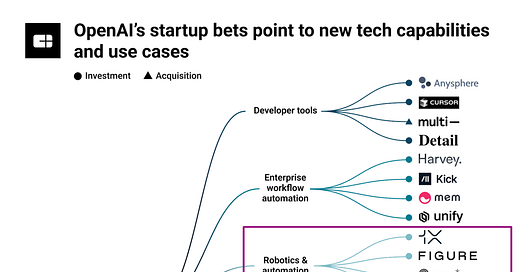OpenAI's Strategic Investment in Robotics and Beyond: Building an Ecosystem for the Future of AI
OpenAI has set its sights on transforming more than just virtual interactions. The company is building an ecosystem integrating AI across various domains through strategic investments and acquisitions, from developer tools and enterprise automation to media and education. A key focus of this strategy lies in robotics and automation—an area requiring massive financial resources and time-intensive research, especially if the goal is to meld AI with physical hardware.
Rather than attempting to construct robotics hardware in-house, OpenAI opts for a networked approach, engaging in partnerships and investments to gradually expand its influence and capabilities in the robotics sector. This strategy was further highlighted earlier this year when OpenAI relaunched its robotics division, explicitly aiming to "unlock new capabilities for our partners' robots," as noted in their job postings. Here’s a closer look at how OpenAI's investment strategy could shape the future of AI-driven robotics and automation.
Why Robotics? The Rationale Behind OpenAI's Focus
AI’s potential is magnified with robotics, bridging the gap between virtual intelligence and real-world applications. OpenAI’s language models, such as ChatGPT, have showcased immense utility in software-based environments, but real-world physical tasks require a different approach. Robotics extends AI’s applicability from digital interfaces to physical interactions, allowing AI to tackle practical, operational challenges in sectors like logistics, healthcare, and manufacturing.
However, creating robots capable of performing complex, dynamic tasks involves hardware and software innovation—a complex and expensive endeavour. This investment in robotics is part of a broader move to ensure that AI-powered automation can more effectively address real-world problems.
The Investment Ecosystem: Building Bridges Through Strategic Bets
Recent data from CB Insights shows that OpenAI's investment strategy spans several categories, including developer tools, enterprise workflow automation, media and content creation, and education technology. This diverse portfolio supports a multipronged approach to innovation. However, the emphasis on robotics and automation is a high-potential yet high-cost venture. OpenAI's critical investments in this area include:
Figure: A robotics company focused on developing humanoid robots capable of operating in human-centric environments.
Physical Intelligence: A company that researches and designs intelligent, adaptive robotic systems for real-world applications.
Ghost: Although shut down in 2024, Ghost’s initial work in autonomous systems could offer insights and partnerships for future self-navigating and responsive robotics developments.
Through these investments, OpenAI is aligning itself with robotics companies that bring hardware and physical intelligence expertise, filling gaps in its capabilities and accelerating the path to functional, scalable robotic systems.
Source: CB Insights, 2024
Enterprise Workflow Automation and Developer Tools: The Digital Foundation
OpenAI’s focus is not limited to robotics. By investing in enterprise workflow automation tools like Kick, Mem, and Unify, OpenAI is embedding its AI models into the daily operations of businesses across industries. These platforms help organisations streamline tasks, reduce redundancy, and leverage data insights to make faster, more informed decisions. For developers, investments in tools like AnySphere and Harvey aim to foster an environment where AI integration is straightforward and accessible, making incorporating OpenAI’s models into various applications easier.
Together, these tools provide the digital foundation for a seamless AI ecosystem where robotics is only one component. Developer tools and workflow automation applications serve as the “back office” of OpenAI’s AI initiatives, ensuring businesses have the infrastructure to support AI-driven robotics and other applications.
Health, Data, and Media: Expanding the Reach of AI
OpenAI’s ecosystem approach extends to other significant sectors:
Health & Well-being: Investments in Ambience and ThriveAI reflect a commitment to improving mental and physical health through AI. These tools could enable more personalised care and data-driven wellness strategies.
Data Management & Infrastructure: Companies like EdgeDB and Rockset enable robust data handling, essential for AI models that rely on vast, dynamic datasets. A robust data infrastructure will be crucial for supporting real-time decision-making in both digital and physical AI applications.
Media & Content Creation: OpenAI's investments in Descript and Diagram point to its interest in democratizing content creation through AI. These platforms allow users to produce and edit media easily, potentially creating synergies with robotics for automated content production and distribution.
The OpenAI Advantage: An Ecosystem for Integrated Intelligence
What sets OpenAI’s strategy apart is its ecosystem mindset. Instead of building in isolation, OpenAI fosters a web of interrelated companies and tools to support and amplify each other’s capabilities. This approach allows the company to expand its influence without shouldering the cost and complexity of building everything in-house.
For example, an OpenAI-powered workflow automation tool could communicate with a humanoid robot from Figure, using real-time data processed by EdgeDB. Or, an automated editing tool from Descript could integrate seamlessly with enterprise software, creating a smoother workflow for content teams. This interoperability is critical to OpenAI's vision: an interconnected ecosystem where AI seamlessly spans digital and physical domains.
The Future of OpenAI’s Robotics Vision
By building partnerships and making targeted investments in robotics and complementary fields, OpenAI is positioning itself to create a new breed of AI-driven applications capable of operating in virtual and physical spaces. As robots become more capable and intelligent, OpenAI's suite of products and investments may form the backbone of a more efficient, data-driven economy where automation is ubiquitous and intuitive.
This strategy allows OpenAI to be at the frontier of robotics without diving into hardware-heavy development, reducing risk while preserving influence. In time, OpenAI's ecosystem could shape the future of work, play, and industry, integrating AI seamlessly into our everyday lives.
Preparing for a Connected Future
As businesses and leaders watch OpenAI’s moves, it’s clear that the company is laying the groundwork for a new era where AI permeates every level of the economy. By leveraging investments across various technology sectors, OpenAI is setting itself up as a provider of AI models and a platform for the future of AI-powered automation, robotics, and intelligence.
For executives, monitoring this ecosystem is crucial: OpenAI’s vision may redefine how work is organised, how companies are structured, and how automation and AI reshape productivity across the board.




